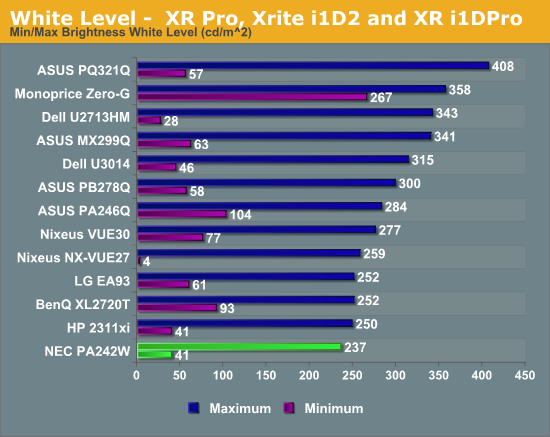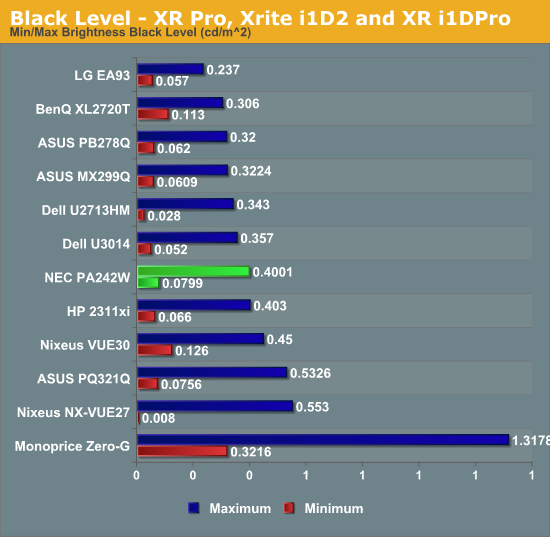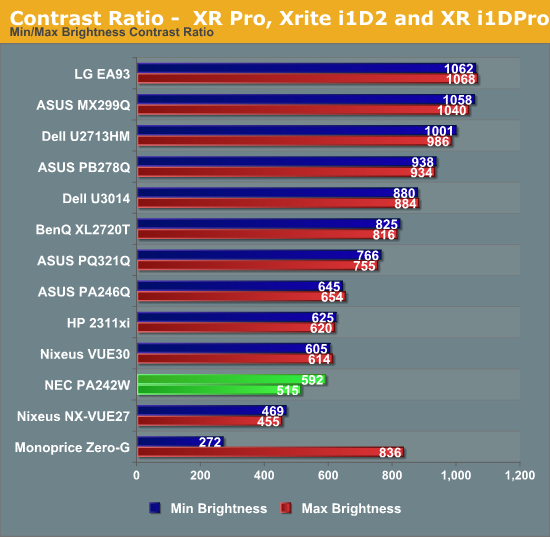NEC PA242W Monitor Review
by Chris Heinonen on September 27, 2013 9:00 AM ESTAs noted on the previous page, NEC limits the upper level of the PA242W backlight to 240 cd/m2. You can go beyond this, but the control turns red to let you know that overall performance is suffering. The construction of the PA242W is designed to make it as uniform and even a display as possible. Pushing the backlight too far will reduce that. No one that is using this monitor in a professional setting would need light output beyond that, so I used that level for the maximum setting here.
If you want to go beyond that, the NEC can produce 287 cd/m^2 at maximum. The minimum setting produces 41.19 cd/m^2, very close to the on screen reading of 40 cd/m^2. The 240 cd/m^2 setting produces 236.7 cd/m^2, also very close. You can adjust this to any level between in 1 cd/m^2 increments. For white level control, the NEC PA242W is unmatched in my experience.

Black level is not quite as good as white level. At the 240 cd/m^2 level we have a black level of 0.4001 cd/m^2 and at the minimum setting we see a level of 0.0799 cd/m^2. That is a very low minimum, but no other monitor has a minimum setting of only 40 cd/m^2 either.

The contrast ratios that result from the above are only fair, 515:1 for the minimum setting and 592:1 for the 240 cd/m^2 level. Curiously the maximum setting produces a contrast ratio of 699:1 indicating that the NEC can do better if you sacrifice uniformity. For movies and TV people typically value contrast ratio above all, but for production work, uniformity might be more important. We will see if this sacrifice winds up being worth it later.











74 Comments
View All Comments
Hulk - Friday, September 27, 2013 - link
I trust Anandtech reviews but that contrast ratio would be a huge concern of mine if I were dropping $1000 on a monitor.noeldillabough - Friday, September 27, 2013 - link
I'm using an older 26" version of this at work and its great...so much so that when I work on a different machine I'm grumbling about the difference!coolhardware - Friday, September 27, 2013 - link
I could not find a 26" (older) version of this monitor, anybody have a model #???asakharov - Sunday, October 6, 2013 - link
NEC 2690WUXIDeath666Angel - Friday, September 27, 2013 - link
If you drop 1k on this you need it for the uniformity and color/calibration results, not for high contrast for your movies and games. :)Hulk - Friday, September 27, 2013 - link
Actually when I do post work for video/photo, lattitude (dynamic range), which is ability to see detail in the darkest and brightest areas is a big deal, as important if not more so than color space and uniformity. A low contrast ratio means that highlights turn into bright blotches and dark areas simply appear crushed.I look for contrast ratio first, then color space, and finally uniformity in a monitor for doing work in post. Uniformity and color space are useless if I can't see any detail in the bright and dark areas.
Senti - Friday, September 27, 2013 - link
You are absolutely wrong about contrast. Contrast is the ratio of pure white to pure black and nothing else. This has nothing to do with ability to display dark and bright shades. Actually, the reverse is true: VA panels have great contrast and awful dark tones reproduction. I can see the difference between all the shades with my NEC PA241W even though its contrast is quite modest.In general, I have to say that displays are definitely not Anandtech's specialization. Not just mine opinion, as I heard several times how disappointed people I know were at the usefulness of such reviews here. Some important points that AT completely missed: 10-bit mode of operation, overdrive errors, refresh rates, impact of different Uniformity setting values.
Hulk - Friday, September 27, 2013 - link
No. You are wrong.Contrast ratio should be high for a good display.
http://en.wikipedia.org/wiki/Contrast_ratio
Furthermore, dynamic range and contrast are closely related and a good display should have a contrast ratio of at least 1000:1.
http://en.wikipedia.org/wiki/Dynamic_range
Finally, you might want to read up on this subjest.
http://www.cambridgeincolour.com/tutorials/dynamic...
Gothmoth - Friday, September 27, 2013 - link
sorry hulk. but you are clueless.look at eizo coloredge or quato monitors.
and don´t argue about something you obviously know not much about.
enjoy the faked contrast ratio numbers of your gaming monitors and google a few more articles that say nothing about actual display quality .
Samus - Saturday, September 28, 2013 - link
Ohh Hulk, throwing wiki links to general topics with no direct data about this monitor (or any other comparison) is fail.No where in Contrast Ratio does it say anything along the lines of quality monitors have high contrast ratio or low-end monitors have weak contrast ratio, etc.